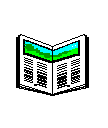Signature
Pagination

|
In any saddle stitched publication, the total number of pages must be divisible by four due to the nature of folding paper. Depending on how the project will be printed, a 12 page publication may be almost as costly as a 16 page because of the added trimming involved in assembling dissimilar signatures. For example, an 8.5" X 11," 16 page program will print entirely on 23" X 35" stock. The sheet is folded three times and trimmed on three sides to make the booklet. With a twelve-page publication, the signature cannot be folded into "thirds" for binding. Since the folds must all be on the same side it must be printed as two pieces -- an eight-page sig and a four-page sig. There are several methods of economizing the paper use for this
publication, but there are added cuts and steps in bindery that add to the cost of such a project.

|
Crossovers

|
A crossover is wherever an image or design element spans two or more pages that are not actually printed side-by-side or even on the same sheet.
|
Creep

|
Creep is the result of folding several sheets of paper together, causing the printed image to "move" away from it's target position. Creep is an issue on any publication that folds, especially saddle-stitched publications. The thickness of the spine can be 3/16" to 1/4". The pages in the center of this
publication get pushed farther and farther toward from the spine and can get dangerously close to the trim edge. To be safe, try to work with a 1/2" margin on all saddle stitched publications over 16 pages.

|
Bleeds
|
A bleed is wherever an image or design element is supposed to continue to the edge of a page. As accurate as equipment is, uncontrollable factors, such as paper stretch due to changes in humidity and the pressures exerted on paper in the process of printing on it, can cause the paper to stretch or shrink. If the image "stops" right on the edge of where it is supposed to trim, it is very likely that you will see a white line down the edges of some of your pieces. To prevent this, always let the image extend at least 1/8" beyond where you intend it to trim.
|